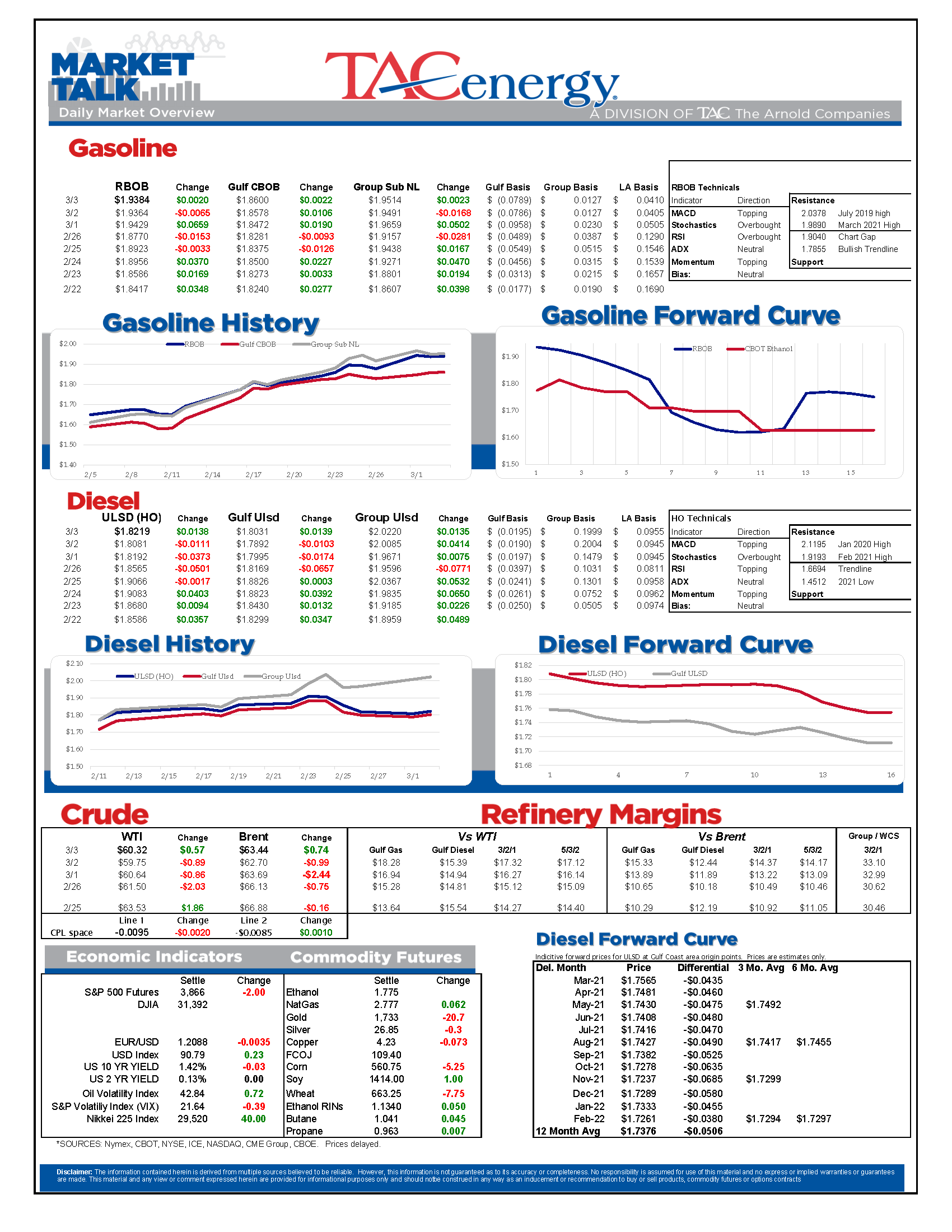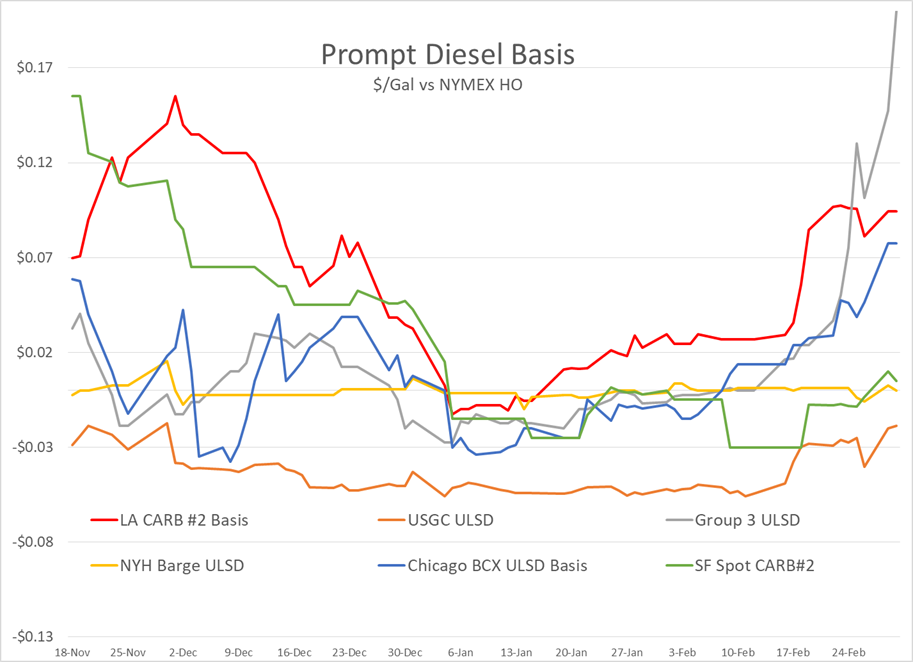Huge Draws In Refined Product Inventories

The four-month-old bullish trend that’s nearly doubled prices for oil and refined products is coming under pressure this week, but so far buyers have been willing to step in each time the chart support is tested. We saw another attempted selloff overnight that pushed WTI below $60, only to see another recovery this morning. This is similar to the back and forth pattern we saw Tuesday morning, which turned into a wave of selling just before the close in the afternoon.
If the bullish trend line finally breaks, we could easily see a $8-10 drop in oil prices and 20-25 cent drop in products over the next month in what could be considered nothing more than an ordinary correction of a major bull market move. If the trend holds however, there’s still a decent fundamental argument for products to rally above $2 this spring and for oil to test $70.
The API’s weekly report was said to show huge draws in refined product inventories last week, as demand recovered faster from the Polar plunge than refineries. Both gasoline and diesel inventories were estimated to be down by more than 9 million barrels/day according to the reports, while crude supplies increased by more than seven million barrels as plants were struggling to restart their processing units. The DOE’s weekly report will be out at its normal time this morning.
Those inventory drawdowns are tangible in markets across the South West and Mid Continent regions, with basis values and rack spreads continuing to spike in several markets this week, with Group 3 ULSD continuing to find itself in the most unusual position as the most expensive diesel in the country, trading at a 20+ cent premium to futures this week. (Charts below) The near term supply situation is getting worse across parts of Texas and the Southwest as refiners continue to struggle with lingering damage that’s slowing restart attempts, and short term outages continue to pop up in New Mexico, Texas, Oklahoma, Arkansas and Louisiana.
For the most part, outages have been limited to diesel and premium gasoline, while regular grades are benefitting from the temporary RVP waivers and relative ease of production they bring. Coastal markets don’t seem to be feeling the squeeze, even though allocations are still not as wide-open as they might normally be this time of year. One thing to watch out for in the coming weeks is premium gasoline supply, which often runs out during the RVP transition given its relatively low demand, and promises to be even more of a challenge this year with refinery output slipping.
RIN prices reached their highest levels since 2013 in Tuesday’s session on the back of stronger grain prices, and expectations for stricter standards to come from the new administration.
The House Committee on Energy and Commerce introduced a new bill that intends to set the U.S. on a path towards zero emissions by 2050, in accordance with the Paris climate agreement. The thousand-plus page bill covers a wide variety of topics, and essentially all sectors of the energy industry, including some tweaks to the RFS. Grant programs to fund various waste-to-fuel programs will be a key topic as the race to produce renewables is setting up a feedstock shortage in the coming years. The bill also includes provisions that refineries requesting exemptions from the Renewable Fuel Standard must share their information publicly.
Meanwhile, the API is reportedly preparing a statement to endorse setting carbon emissions pricing as a way to set a viable economic path towards reaching the Paris agreement. Needless to say, the oil industry group’s plan is expected to look quite a bit different than the one being floated in the House.
OPEC & Friends hold their official meeting tomorrow, so expect the rumor mill to be cranked up over the next 24 hours and keep the oil & product markets on edge.
Click here to download a PDF of today's TACenergy Market Talk.
Latest Posts
Crude Oil Inventories Climbed Above Year-Ago Levels For The First Time In 2024
Week 17 - US DOE Inventory Recap
The Energy Complex Is Trading Modestly Lower So Far This Morning With WTI Crude Oil Futures Leading The Way
Energy Futures Are Drifting Quietly Higher This Morning
Social Media
News & Views
View All
Crude Oil Inventories Climbed Above Year-Ago Levels For The First Time In 2024
Sell by May then go away.
The old trading adage looked good for energy markets in 2024 as the new month started off with the biggest daily sell-off of the year so far. WTI and ULSD contracts are now in “rally or else” mode on the charts with sharply lower prices a strong possibility now that technical support layers have broken down. RBOB doesn’t look quite as bearish on the charts, but seasonal factors will now act as a headwind as we’re well into the spring peaking window for gasoline prices, and we’ve already seen a 27 cent drop from the highs. If RBOB can hold above $2.50 there’s a chance to avoid a larger selloff, but if not, a run towards $2.20 for both gasoline and diesel looks likely in the months ahead.
The selling picked up steam following the DOE’s weekly report Wednesday, even though the inventory changes were fairly small. Crude oil inventories continue their steady build and climbed above year-ago levels for the first time in 2024. Demand for refined products remains sluggish, even after accounting for the RD consumption that’s still not in the weekly reports, and most PADDs are following a typical seasonal inventory trend. The Gulf Coast saw a healthy build in diesel inventories last week as the export market slowed for a 3rd straight week. Refinery runs dipped modestly last week following a handful of upsets across the country, but overall rates remain near normal levels for this time of year.
The Transmountain pipeline expansion began operations yesterday, completing a 12-year saga that has the potential to materially change refining economics for plants in the US that relied heavily on discounted Canadian crude to turn profits over the past decade.
The P66 Borger refinery reported another operational upset Monday that lasted a full 24 hours impacting a sulfur recovery unit. Last week the company highlighted how the plant’s fire department helped the surrounding area when the largest wildfire in state history came within feet of the facility.
The EPA approved a new model to determine life cycle carbon intensity scores this week, which cracks open the door for things like ethanol to SAF, which were previously deemed to not reduce emissions enough to qualify for government subsidies. The new model would require improved farming techniques like no-till, cover crop planting and using higher efficiency nitrogen fertilizer to limit the damage done by farms that no longer rotate crops due to the ethanol mandates. Whether or not the theoretical ability to produce SAF comes to fruition in the coming years thanks to the increased tax credit potential will be a key pivot point for some markets that find themselves with too much RD today, but could see those supplies transition to aviation demand.
The FED continues to throw cold water on anyone hoping for a near term cut in interest rates. The FOMC held rates steady as expected Wednesday, but also highlighted the struggles with stubbornly high inflation. The CME’s Fedwatch tool gave 58% odds of at least one rate cut by September before the announcement, and those odds have slipped modestly to 54% this morning.

Week 17 - US DOE Inventory Recap

The Energy Complex Is Trading Modestly Lower So Far This Morning With WTI Crude Oil Futures Leading The Way
The energy complex is trading modestly lower so far this morning with WTI crude oil futures leading the way, exchanging hands $1.50 per barrel lower (-1.9%) than Tuesday’s settlement price. Gasoline and diesel futures are following suit, dropping .0390 and .0280 per gallon, respectively.
A surprise crude oil build (one that doesn’t include any changes to the SPR) as reported by the American Petroleum Institute late Tuesday is taking credit for the bearish trading seen this morning. The Institute estimated an increase in crude inventories of ~5 million barrels and drop in both refined product stocks of 1.5-2.2 million barrels for the week ending April 26. The Department of Energy’s official report is due out at it’s regular time (9:30 CDT) this morning.
The Senate Budget Committee is scheduled to hold a hearing at 9:00 AM EST this morning regarding a years-long probe into climate change messaging from big oil companies. Following a 3-year investigation, Senate and House Democrats released their final report yesterday alleging major oil companies have internally recognized the impacts of fossil fuels on the climate since as far back as the 1960s, while privately lobbying against climate legislation and publicly presenting a narrative that undermines a connection between the two. Whether this will have a tangible effect on policy or is just the latest announcement in an election-yeardeluge is yet to be seen.
Speaking of deluge, another drone attack was launched against Russian infrastructure earlier this morning, causing an explosion and subsequent fire at Rosneft’s Ryazan refinery. While likely a response to the five killed from Russian missile strikes in Odesa and Kharkiv, Kyiv has yet to officially claim responsibility for the attack that successfully struck state infrastructure just 130 miles from Moscow.
The crude oil bears are on a tear this past week, blowing past WTI’s 5 and 10 day moving averages on Monday and opening below it’s 50-day MA this morning. The $80 level is likely a key resistance level, below which the path is open for the American oil benchmark to drop to the $75 level in short order.
Click here to download a PDF of today's TACenergy Market Talk.




